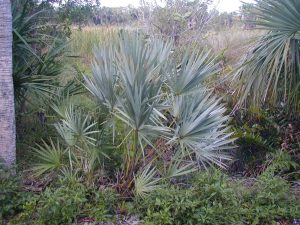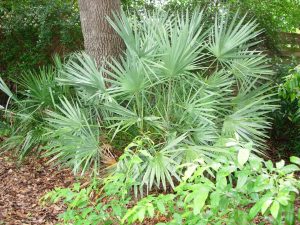Silver Saw Palmetto, Serenoa repens ‘Silver’

Photo by Jenny Evans

Photo by Harriett Wright
Height: 5-8+ feet, depending on form
Spread: 3-8 feet
LANDSCAPE USE
Used as a specimen shrub, in mass plantings, to conceal the open space under decks and raised patios, and to soften and beautify parking lots.
FORM
A reclining to upright, thicket-forming palm, often with a creeping, prostrate trunk but some times trained into a slender tree.
NATIVE RANGE
Coastal flatwoods and dunes, Central through Southeast Florida.
CHARACTERISTICS
Flowers: Tiny, white, borne in conspicuous dusters on elongated, branched inflorescences. Spring and summer.
Leaves: Fan-shaped, lighter blueish-green, bordering on light silvery blue, due to waxy coating, 3-4 feet long and wide, borne at the apex of a long leaf stalk that is armed along its margins with saw-like teeth.
Fruit: A conspicuous, elliptical, 1-inch-long drupe, orange when fresh, turning blue-black to black at maturity. Summer and fall.
Bark: Trunks covered with brownish, fibrous scales.
CULTURE
Soil: Well- to poorly drained, sandy soils including scrub and back of beach dune sands. Extremely salt tolerant.
Exposure: Full sun to light shade.
Water: No irrigation after establishment.
Hardiness Zones: 8 to 11
Life Span: Saw palmetto is extremely long-lived. Those in well-established natural communities have been estimated to be thousands of years old.
BEST FEATURES including WILDLIFE SUPPORT
Highly prized for its beautiful foliage. Long life. Thicket-forming habit. Tolerance of difficult situations such as parking lots and roadsides. Fruit is relished by a variety of wildlife, including deer, hears, and turkeys. Over 300 species of insects use this plant and it is a critical nectar source for many pollinators in the spring. Almost no maintenance once established and no irrigation.
COMPANION PLANTS
Sand Live Oak (Q. geminata), Pigeon Plum or Sea Grape (Coccoloba diversifolia or C. uvifera), Cherokeebean or Coralbean (Erythrina herbacea), Randia (Randia aculeata), Fiddlewood (Citharexylum spinosum), Florida Privet (Forestiera segregata), any of the native stoppers (Eugenia and Myrcianthes spp.), Wild Coffee (Psychotria spp.), Marlberry (Ardisia escallanioides) and Myrsine (Myrsine cubana). Can be mixed with the normal green Palmetto (Serenoa repens).
DISADVANTAGES
May require annual removal of old leaves to maintain a neat appearance. If planted away from the coast, the foliage may turn more green over time (reported, not verified). Saw Palmetto is under threat by poachers due to pharmaceutical/nutraceutical industry market pressure. Expect to defend your plants. Permits required for seed collection.
SIMILAR AND RELATED SPECIES
Green Saw Palmetto differs primarily in foliage color. Blue-stem Palmetto (Sabal minor) and Needle Palm (Rhapidophyllum hystrix) are similar but lack the saw-toothed stem of Saw Palmetto.